Beginner's Guide to Kitesurfing: Techniques and Gear

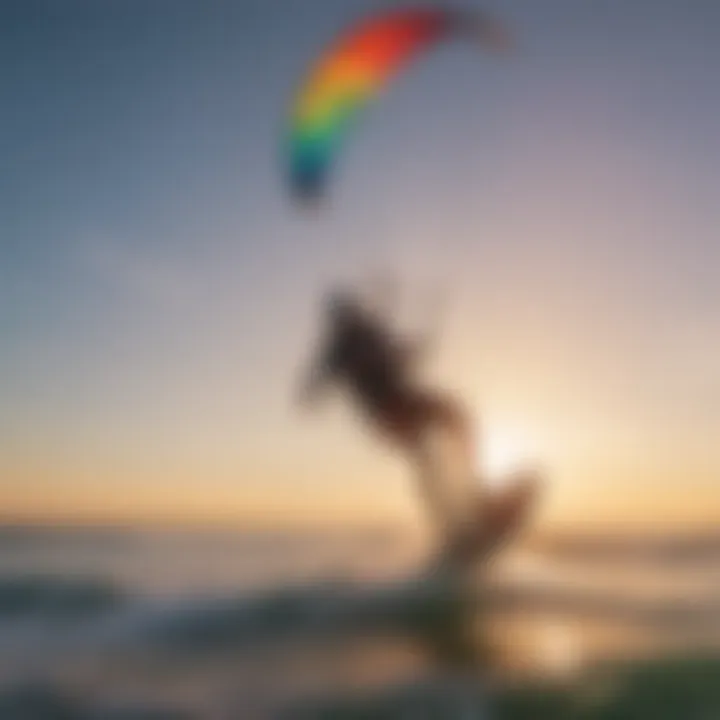
Equipment Reviews
When you step into the world of kitesurfing, choosing the right gear is akin to selecting the perfect tools for a craftsman. Each piece of equipment plays a crucial role in your journey, affecting your performance and overall experience. Let’s delve into the nitty-gritty of kites, boards, and accessories.
Kites: An Overview
Kites are the heart and soul of kitesurfing. They come in various shapes and sizes, each designed for specific wind conditions and skill levels. For instance, the C-kite provides excellent performance for tricks, while the Delta kite offers greater stability, making it suitable for beginners. The material is also essential; modern kites often use ripstop nylon for durability. Popular brands like North and Airush have established themselves for reliability and innovation.
Here are a few key types to consider:
- SLE Kites: These are versatile and good for varied conditions.
- Foil Kites: Ideal for light wind conditions, catering to those slow and steady days.
- All-around Kites: A reliable choice for those just getting started, providing a balanced experience.
Boards: Choosing the Right Ride
Next up is the board. It’s your connection to the water, and picking the right one can make all the difference. There are mainly two types: twintips and directional boards. A twintip is symmetrical, allowing you to ride in either direction, perfect for beginners and freestyle enthusiasts. Meanwhile, directional boards are designed for riding waves, offering a different feel and performance.
When browsing through options, focus on aspects like design and construction:
- Twintip Boards: Good for all-around riding, easy to learn on.
- Directional Boards: Best suited for wave riding, they may require a bit more skill.
Accessories: The Essentials
Often overlooked, accessories are what keep you safe and enhance your riding experience.
Here’s a rundown of must-have gear:
- Harness: This is more than just a support mechanism; it's how you connect with the kite. Look for options with comfort and durability.
- Lines: Vital for steering, these should be tailored to your kite choice.
- Safety Gear: This includes helmets and impact vests. Don’t skimp on safety, as they protect against unforeseen accidents.
- Pumps: A good pump can make inflating your kite a breeze.
It’s wise to invest time in researching gear tailored to your riding style.
Travel Destinations
When you think about where to kite surf, the right spot can transform a good day into an unforgettable adventure. Popular destinations draw thousands for good reason, yet hidden gems are often where the real fun lies.
Popular Spots
There’s a list of go-to places for kitesurfing enthusiasts worldwide:
- Tarifa, Spain: Known for its exceptional wind conditions and vibrant culture, this spot draws both locals and travelers alike.
- Cabarete, Dominican Republic: Flooded with charm, the steady trade winds here create a perfect playground for kitesurfers at all levels.
- Maui, Hawaii: The dream of many, here you'll find stunning scenery and high winds, ideal for the adventurous.
Off the Beaten Path
For those looking to escape the crowds, consider lesser-known locations:
- Dahab, Egypt: This laid-back town has stunning lagoons and consistency in wind but is quieter than more famous hotspots.
- Ninh Thuan, Vietnam: With its clear waters and beautiful landscapes, it’s a perfect hideaway for kitesurfing enthusiasts seeking something unique.
Techniques and Tutorials
Time for the fun part! Understanding techniques is essential, and diving into the sport step-by-step can make all the difference.
Beginner Guides
Learning the ropes—quite literally—is crucial:
- Launching: Find a clear area and signal a friend, use the wind to get your kite into the air.
- Riding: Practice balance while keeping an even kite. Start with shorter runs to build confidence.
- Turning: Shift your weight and adjust your kite's angle to change direction.
- Landing: Approach your landing spot with control, and signal your buddy to help guide you safely.
Advanced Skills
As you progress, it’s time to challenge yourself with more maneuvers:
- Jumps: Build speed, pull the kite, and use your legs to pop off the water.
- Tricks: Nailed the basics? Start throwing in spins and grabs.
- Wave riding: Get comfortable on your directional board and learn to read the swell.
Safety Guidelines
Lastly, let’s not forget safety—the unsung hero of any sport.
Weather Conditions
Knowledge of wind, currents, and tides can make or break your experience. Monitor local conditions and always have a backup plan.
Emergency Protocols
Familiarize yourself with rescue tactics. Having a plan for accidents can oftentimes make all the difference. Whether it’s dealing with a sudden fall or a deflated kite, knowing how to respond is key.
Equipment Maintenance
Ensure your gear is always in top shape. Regular checks on lines, kites, and boards are essential to prevent mishaps. Maintain your equipment to guarantee a safe and enjoyable experience.
"The best preparation for tomorrow is doing your best today."
This phrase rings true for aspiring kitesurfers.
With all this knowledge in your back pocket, you're better equipped to chart your course in the exciting world of kitesurfing. Happy surfing!
Prolusion to Kitesurfing
Kitesurfing is not merely a sport; it embodies a lifestyle that exhilarates the adventurous spirit within. For novices, grasping the essence of kitesurfing sets the stage for not just lessons, but an immersive experience filled with thrills and challenges. This section seeks to illuminate why understanding the foundational aspects of kitesurfing is paramount for anyone looking to take to the waves.
Understanding the Sport
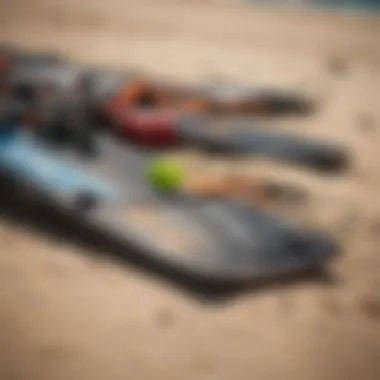

At its core, kitesurfing combines elements of surfing, windsurfing, and paragliding. You’ve got a board strapped to your feet, while a large kite catches the wind, propelling you across water’s surface. The simple act of gliding across waves invokes a sense of freedom that is hard to replicate elsewhere.
For beginners, it’s essential to grasp not just the mechanics of the sport but the rhythm of the wind and water. This knowledge transforms what might seem like random chaos—choppy waves and gusty winds—into a dance with nature. Those first steps on the board can be daunting, yet they’re also surprisingly rewarding. Finding your balance is crucial, as the initial struggle is something every experienced kitesurfer has endured and emerged stronger.
Equipped with a kite and board, a beginner must also befriend the ocean, learning to understand its moods—those swirling zealots of waves and shifts in the breeze that almost seem to have a language of their own. Soon, you'll find yourself riding the crest of a wave, feeling both the thrill and the liberation kitesurfing affords.
The History of Kitesurfing
Kitesurfing's history is as colorful as the kites that fill the sky. Its origins can be traced back to ancient times, where various forms of kite flying were practiced in Asia. But it wasn’t until the late 20th century that kitesurfing evolved into the adrenaline-pumping sport we know today.
The 1970s saw the first uses of kites for board sports, with inventors like Pierre Dreply experimenting with kite designs. However, it was in the 1990s that the sport began to gain traction, particularly in Hawaii and France. Early adopters took to the water, hopeful and bold, armed with homemade kites and a thirst for innovation.
By the turn of the century, kitesurfing evolved rapidly. Companies like Naish and Cabrinha emerged, introducing better designs that allowed for more control and ease of use. The sport matured, drawing in enthusiasts from all walks of life, leading to the establishment of competitions and kitesurfing communities across the globe. Today, kitesurfing showcases an impressive mix of acrobatic aerial maneuvers and surf-style riding—all elements that stem from a rich history layered with persistence, creativity, and, above all, respect for nature.
"The history of kitesurfing is a testament to human ingenuity, showcasing our relentless pursuit to harness the power of the wind."
Understanding kitesurfing’s evolution offers newcomers a deeper appreciation of the tools and techniques they’ll encounter. This knowledge can turn novice enthusiasm into wisdom, enriching the overall experience on the water.
Essential Gear for Beginners
When it comes to kitesurfing, having the right gear is like hitting the jackpot for your experience on the water. Your equipment not only impacts how well you can perform in different conditions but also plays a vital role in your safety and enjoyment. This section delves into the essential gear every novice should consider, covering kites, boards, safety equipment, and other accessories. Picking the right gear makes all the difference as you set out to ride the waves.
Kites
Types of Kites
Choosing the right kite can feel like navigating a spaghetti bowl of options. Generally, kites are categorized into three main types: delta, bow, and c-kites. Each type has its own unique characteristics that cater to different weather conditions and riding styles.
- Delta Kites: Known for their ease of use, delta kites offer stability and a large wind range. They're great for beginners keen on straightforward handling.
- Bow Kites: Popular for their ability to depower easily, bow kites give riders more control in gusty winds. These are favored by those who want to push their limits while still keeping safety in mind.
- C-Kites: For those who crave performance, C-kites deliver incredible jumping ability and speed, but they can be challenging for beginners.
The specific benefits of each type depend largely on the conditions where one plans to ride. If you're seeking a smooth entry into kitesurfing, delta kites might just be the best option.
Choosing the Right Size
The size of your kite is paramount to your experience. Larger kites provide more power, making them better for lighter wind conditions, while smaller kites are suited for windier conditions. The key characteristic here is that bigger isn't always better. A kite that's too large can be difficult to control, especially for newcomers who are still fine-tuning their skills.
- A common size range for beginners typically falls between 8 and 12 meters. Choosing the right size is a beneficial option as it allows riders to develop their control and technique without being overpowered.
- An important thing to note is that a kite’s size should also consider the rider’s weight and the wind conditions on any given day. This will significantly affect how well you manage the kite and ultimately how enjoyable the ride is.
Boards
Types of Boards
Just like kites, boards come in various types such as twin tips, directional boards, and surfboards. Each is engineered for specific riding styles.
- Twin Tips: Ideal for beginners, these boards allow riding in both directions and are easy to maneuver. They’re all about versatility and simplicity.
- Directional Boards: Best suited for waves, these boards resemble surfboards, often providing better performance in choppy water.
- Surfboards: Designed primarily for wave riding, surfboards require additional skills but offer an exhilarating ride once you’re up to speed.
Gaining familiarity with the board type that suits your style can make a world of difference when you’re out on the water.
What to Look For
When shopping for boards, prioritize aspects like material, stiffness, and board shape. Each of these elements contributes to how well the board performs under specific conditions.
- Material: A board made from high-quality materials generally lasts longer and performs better.
- Stiffness: Stiffer boards offer more direct control, but softer boards provide more comfort in choppy conditions.
Taking the time to find a board that aligns with your riding style and skill level is a worthwhile investment for both performance and enjoyment.
Safety Equipment
Harnesses
A harness is not just an accessory; it's a lifeline connecting you to the kite. Choosing the right type of harness—either waist or seat—is crucial for comfort and control.
- Waist Harnesses: Provide greater freedom of movement and are favored for freestyle riding.
- Seat Harnesses: Offer more support for new riders, distributing the pull on your body more effectively.
Investing in a good harness can mean the difference between a fun day on the water and a discomfort-filled experience.
Helmets
While kitesurfing looks glamorous, it's also unpredictable. Wearing a helmet should never be viewed as a hassle; rather it's a smart choice.
- Properly fitting helmets protect against falls and obstacles. Some helmets even come equipped with flotation features.
- However, you should ensure your helmet is ventilated well, as a hot head can lead to plenty of frustration out there.
Prioritizing safety with proper headgear can add an extra layer of confidence.
Life Jackets
Life jackets are not mere afterthoughts. They are essential pieces of equipment, especially for beginners.
- Look for life jackets designed specifically for kitesurfing. They provide greater mobility while ensuring you can stay afloat when needed.
- However, be mindful that some life jackets may restrict movement, and it’s vital to find one that strikes a balance between safety and usability.
Other Accessories
Wetsuits
A wetsuit is crucial for maintaining body temperature in cooler waters.
- Thickness: Generally, a 3/2 mm wetsuit is suitable for most climates, but in cold waters, a thicker option may be necessary.
- Think about flexibility too. A wetsuit that allows for full range of motion will enhance your experience significantly.
Footwear
Footwear is another often-overlooked aspect of kitesurfing gear, but it can enhance grip and comfort.
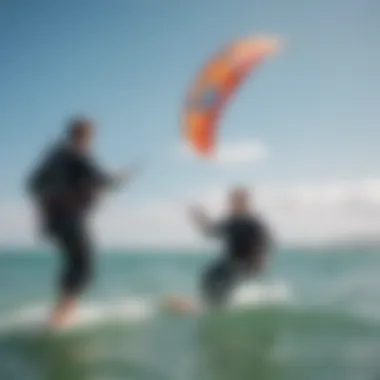
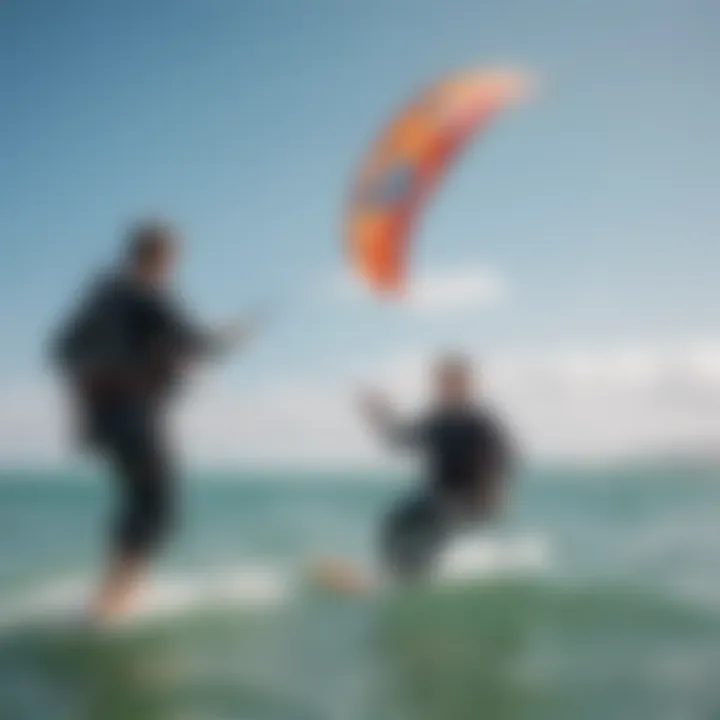
- Booties: Provide the necessary warmth and protection, especially in rocky coastal areas.
- Sandals: Offer ease when walking on the beach but should be avoided while kiting.
Bar and Lines
Finally, the control bar and lines are vital for steering your kite.
- Lines should be durable yet lightweight, making them easy to manage in the air.
- The control bar must fit well in your hands, allowing for easy adjustments without any hassle.
It’s essential to choose quality equipment in every category. Getting it right does not just enhance your experience; it keeps you safe as you navigate the thrilling world of kitesurfing.
Learning the Basics
Understanding the fundamentals of kitesurfing is crucial for anyone looking to embark on this thrilling sport. In this section, we'll tackle various aspects that are essential for beginners, from finding the right location to mastering kite control and essential techniques.
Finding a Suitable Location
Ideal Conditions
When it comes to kitesurfing, finding the right location can make or break your experience. Ideal conditions depend heavily on the wind and water state. The best spots often have consistent, moderate winds and flat water. Places like the flat beaches of Cabarete or the shallow lagoons in Tarifa are popular areas. The wind should ideally be between 12 to 25 knots for beginners, as stronger winds can create more challenging conditions.
The key characteristic of these ideal conditions is safety combined with ease of learning. Flat water reduces the risk of injury and helps newcomers focus more on mastering their kite control without the diversions of waves crashing around them. That said, improper conditions can lead to serious troubles; strong winds or choppy water can overwhelm a beginner.
"The right beach can be your best friend; the wrong one, your worst enemy."
Local Regulations
Local regulations play a pivotal role in ensuring a safe and enjoyable kitesurfing experience. Each area often has specific rules about where you can launch or land your kite, speed limits, or designated kite zones. Ignoring these regulations can not only affect your safety, but also the safety of others.
It's crucial to understand these guidelines, such as no riding within certain areas or the times when kitesurfing is permitted. Being aware of local regulations shows respect for the environment and other water users, which can enhance your experience in the long run. Not to mention, breaking the rules can lead to fines or damaged relationships with local kitesurfing communities.
Kite Control Fundamentals
Kite control is the backbone of kitesurfing; without it, you wouldn't get far, literally. Learning to operate your kite effectively involves mastering the positioning and responsiveness of the kite to the wind. Here, you will develop an intuition for how your kite reacts in varying wind conditions.
Understanding the bar pressure and how it affects your kite's performance is also key. It’s about feeling the kite, not just pushing buttons. Practicing the basics on land can help you gain confidence and skills that directly translate to the water.
Essential Techniques
Launching and Landing
Mastering launching and landing your kite is fundamental. A successful launch requires communication with your partner if you're launching with someone. Make sure you're aware of the wind direction, obstacles, and the position of your kite.
The key characteristic of these maneuvers is timing. Launch and land at the right time and you'll save yourself from unnecessary trouble. If something goes wrong during launch or landing, it can quickly escalate into a dangerous situation.
The unique feature of mastering this technique is its versatility in different conditions. The methods can vary considerably depending on the wind strength and water state, providing both advantages and potential challenges depending on the situation.
Riding Position
An effective riding position plays a significant role in ensuring balance and control. Beginners often overlook this aspect. The right stance will allow you to harness the power of the kite without losing your footing in the water. You should maintain a slight bend in your knees and keep your body low to balance effectively.
The key characteristic here is stability. A solid riding position enables you to respond to the unpredictable nature of wind and waves. Getting this position right is a favorable angle to maximize your enjoyment and minimize mishaps. If not properly addressed, a poor riding position can lead to crashes or falls, which are tough on both your confidence and body.
Safety Considerations
In kitesurfing, safety isn't just a side note; it's the headline act. Understanding the potential hazards and how to deal with them can mean the difference between a thrilling ride and a disastrous experience. In this section, we’ll explore critical elements of safety that every beginner kite surfer should pay heed to.
Understanding Wind Conditions
Wind is the lifeblood of kitesurfing, but it can also be a double-edged sword. As you step into this exhilarating sport, grasping the intricacies of wind conditions is crucial. It’s not merely about knowing if it's breezy outside; it’s about discerning whether those winds are friendly or ferocious. Beginners should learn to check wind speed, direction, and any changing patterns. Factors such as gusty winds can sneak up on a novice, leading to erratic kite behavior and potentially risking safety. Understanding local weather reports or apps can provide vital insight into the day’s wind forecast.
Communicating on the Water
Communication out on the water makes a world of difference. If you’re kite surfing with a buddy, knowing how to signal each other can prevent mishaps. A simple thumbs-up can mean all is well, while a raised hand may signal distress. Also, being aware of the rules of the water—for instance, right of way—is essential. If you’re riding in a crowded area, knowing when to give way can keep everyone safe. Remember, a simple whistle or shouting might not reach each other due to the sound of the waves and wind. Thus, hand signals become invaluable.
Emergency Procedures
Even the most seasoned kitesurfer knows that things can go awry. Having a string of emergency procedures tucked into your belt can bolster confidence and enhance safety. It’s advisable to familiarize yourself with self-rescue techniques and risk recognition.
Self-Rescue Techniques
Self-rescue techniques are not just about knowing how to operate your equipment but also understanding the situation. If you find yourself in trouble, such as getting tangled or losing control, self-rescue enables you to safely return to shore without needing outside help. This is particularly beneficial in isolated spots where rescue might take longer.
One hallmark of self-rescue methods lies in depowering your kite. This involves relinquishing tension in your lines and allowing the kite to float down safely instead of being tossed around. The best part? The techniques can be practiced on land, so you feel comfortable executing them under pressure. This prepares you better than a deer in headlights when the stakes are high.
Recognizing Risks
Recognizing risks is about more than just spotting turbulence in the water. It’s about understanding your limits, the capabilities of your gear, and adapting your approach accordingly. For instance, riding at too high a tide or encountering obstacles in your path could lead to injury or equipment damage.
One key characteristic of risk recognition is situational awareness. Learning to assess your surroundings—including other riders, shoreline conditions, and potential weather changes—allows you to navigate the waters smoothly. This proactive mindset not only protects you but also enhances the overall kitesurfing experience.
"The more you know about your environment and gear, the more fun you'll have and the safer you'll stay."
Being generally aware and prepared to make quick decisions is a hallmark of a wise kitesurfer. Though it may seem like a lot to grasp, taking the time to familiarize yourself with safety considerations allows you to enjoy kitesurfing to its fullest. Make a habit of assessing risk and implementing safety measures, and it won’t be long before you’re riding the waves with a sense of ease, like you were born to do it.
Joining the Kitesurfing Community
Engaging with the kitesurfing community can profoundly enrich your experience as a beginner. It's not just about mastering the wind and waves; it’s about connecting with others who share your passion. This network can offer invaluable support, advice, and, most importantly, a sense of belonging. Whether you're learning the ropes or honing your skills, being part of a community can make the journey smoother and more enjoyable.
Finding Local Schools and Instructors
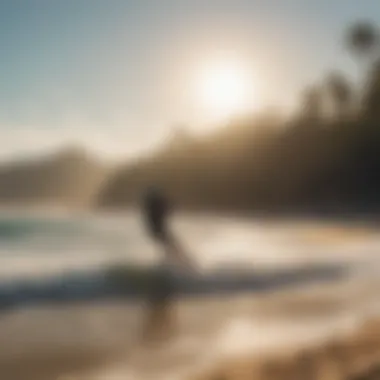
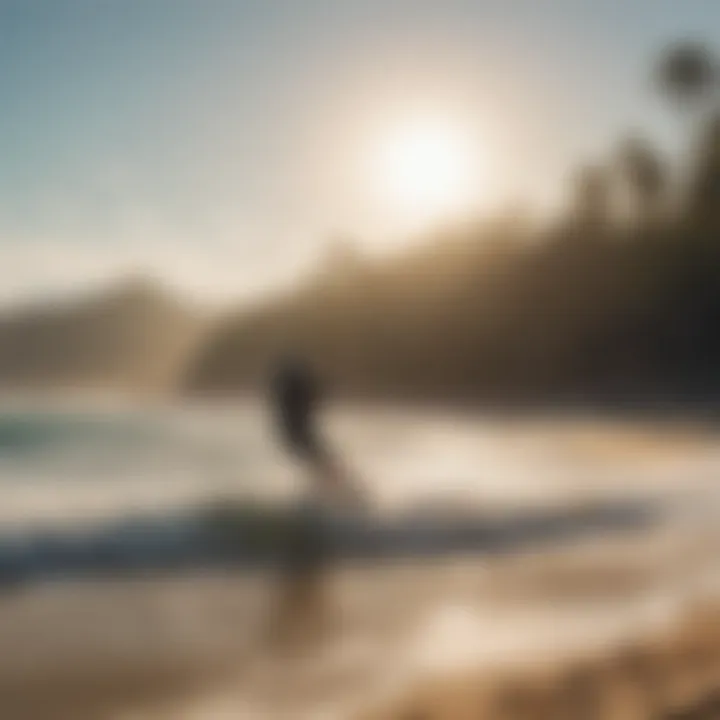
One of the first steps in your kitesurfing journey is identifying local schools and instructors. They play a crucial role in teaching you the fundamentals and ensuring you grasp the necessary safety measures. The advantages of seeking professional guidance include access to structured lessons, expert feedback, and the ability to practice in a controlled environment. When searching for a local school, consider:
- Qualified Instructors: The school's instructors should have proper certifications. Certifications like those from the International Kiteboarding Organization (IKO) ensure that they meet industry standards.
- Reputation: Look for schools with positive reviews. Websites like Facebook and Reddit have groups and pages where former students share their experiences.
- Equipment Availability: A good school provides equipment, which is helpful for beginners who are still figuring out what fits their needs.
- Location Convenience: Proximity to your home or accommodation can influence how easily you can attend classes and practice.
Competition Overview
Competing in kitesurfing can be an incredibly exhilarating experience, whether you’re aiming to showcase your skills or simply enjoy the thrill of the environment. Competitions are essential for growth, offering both local events and international tournaments that cater to varying levels of experience.
Local Events
Participating in local events allows for friendly competition and fosters a supportive environment. These gatherings are typically designed for all skill levels and prioritize community building over cutthroat competition. Local events often include:
- Accessibility: They are generally easier to join, making it perfect for beginners who want to test their skills in a relaxed atmosphere.
- Networking Opportunities: Meeting other kitesurfers locally can lead to friendships and mentorships that can help you improve.
- Sponsorship and Prizes: Many events offer prizes, which could range from equipment discounts to gear giveaways, encouraging newbies to jump in and participate.
However, keep an eye on the level of competition; some beginners may feel intimidated at highly competitive local events, so it can be beneficial to join less intense ones for a smoother introduction.
International Tournaments
International tournaments present a different kettle of fish. They often showcase the best of the best, drawing skilled competitors from around the globe. Such events highlight:
- Skill Development: Watching top athletes can provide insights into advanced techniques and styles that you might adopt into your own practice.
- Exposure: Competing or even spectating can inspire you and widen your understanding of the sport. Additionally, you may discover diverse kitesurfing cultures, which adds to the experience.
- Travel Opportunities: International competitions often take place in exotic locations, merging your passion for kitesurfing with the joy of exploring new places.
Yet, you should be mindful as these events can be demanding; they require a solid skill level and commitment to participate effectively.
Connecting with Other Enthusiasts
The heart of the kitesurfing community beats strongest when enthusiasts connect and share experiences. Engaging with others can take many forms—from joining social media groups to local meetups or even trips to popular kitesurfing destinations. Benefits of connecting with others in the community include:
- Shared Knowledge: Enthusiasts are often happy to share tips and tricks that helped them learn.
- Group Rides: Kitesurfing with others can boost your confidence, and makes for a more enjoyable day on the water, fostering a spirit of camaraderie.
- Mentorship and Support: Establishing friendships may lead to finding a mentor who can provide you personalized guidance as you advance.
Maintenance and Care of Equipment
Taking proper care of your kitesurfing gear is crucial for both safety and performance. It’s not just about ensuring your equipment looks good; it's about making sure it operates effectively and lasts longer. Maintaining your gear involves regular cleaning, correct storage, and being proactive about repairs. When you invest in equipment, you want to ensure you're getting the most out of it, and proper maintenance can significantly extend the lifespan of your kites and boards.
When gear is well-maintained, it can perform better, which translates to a smoother and more enjoyable kitesurfing experience. A kite that flutters less in the wind or a board that glides effortlessly can be the difference between a thrilling ride and a frustrating one. Additionally, maintaining gear also reduces the risk of accidents caused by equipment failure, which can occur without sufficient care.
Cleaning and Storing Kites
Kites are your primary tool in kitesurfing, and proper cleaning and storage are essential. After each session, thoroughly rinse your kite with fresh water to remove salt, sand, or any debris that might have clung on. Salt and sand are notorious for causing wear over time, not just on the fabric but also on delicate stitching and seams.
Here are some practical steps to keep in mind:
- Rinse with Care: Use a gentle stream of water, avoiding high-pressure hoses that may damage the fabric.
- Dry it Out: After rinsing, hang your kite upside down to ensure it's completely dry. Avoid direct sunlight as prolonged exposure can degrade the material.
- Check for Damage: While the kite is drying, take a moment to inspect it for any tears or abrasions. Addressing issues early can prevent larger repairs down the line.
When it comes to storage, you want to choose a cool, dry place away from direct sunlight. A kite bag is not just for transport; it also protects your kite from accidental impacts and environmental damage. Storing kites deflated will extend their lifespan significantly, as inflation can put pressure on seams and material.
"Remember, a well-cared kite is a happy kite. Treat it right, and it’ll fly true for many seasons to come."
Board Preservation Techniques
Just like with kites, your board also requires regular upkeep. Boards can be susceptible to scratches and dings, especially when you're navigating through rough waters. Here are some tips you can use to keep your board in tip-top shape:
- Rinsing Off: Just like with kites, give your board a good rinse after each session. This will help remove salt and debris from the surface. Use a soft cloth to wipe it down afterwards.
- Inspect Regularly: Look for any scratches or damage on the board. Small scratches can often be repaired using specialized epoxy or repair kits available in stores.
- Store Carefully: Keep your board out of direct sunlight and away from heavy objects that might cause dents. If possible, use a board bag for transportation and storage.
- Avoid Excessive Heat: Never leave your board in a hot car or near a heat source. High temperatures can warp the board and affect its performance.
By following these basic maintenance and care steps, you can ensure that your kitesurfing equipment continues to perform at its best. Ultimately, while kitesurfing is about enjoying the ride, proper care will give you peace of mind and make your time on the water all the more enjoyable.
Resources for Further Learning
When it comes to advancing in kitesurfing, the importance of continuous learning cannot be overemphasized. The sport is ever-evolving, and having a solid grasp of the latest techniques, safety measures, and gear innovations can make a significant difference in your performance. Moreover, engaging with resources helps newcomers build on their foundational knowledge, paving the way for greater confidence and skill as they take to the waves or the skies.
Whether you're looking to refine your skills, stay updated on the latest gear, or connect with like-minded individuals, diverse resources can cater to these needs. Online tutorials, books, and magazines all serve as accessible avenues for kitesurfers eager to enhance their understanding and technique.
Online Tutorials and Videos
In an age dominated by digital learning, online tutorials and videos provide an effective way for beginners to visualize techniques and safety protocols. Platforms like YouTube host a multitude of channels dedicated to kitesurfing, offering everything from basic instructional videos to advanced trick tutorials.
- These resources typically showcase the kitesurfing process in action, breaking down moves and providing verbal explanations that enhance comprehension.
- Look for tutorials that are organized into playlists based on skill levels. This way, you can find content tailored to your current abilities and progress at your own pace.
- Don’t overlook community feedback; tutorial comment sections can be a treasure trove of additional tips and personal experiences.
Furthermore, you might find that certain instructional series build upon each other, establishing a curriculum-like structure that makes learning feel more structured. Popular channels include KiteSurfing Academy and The Kiteboarder Magazine's educational series, which often collaborate with experienced riders and instructors.
Books and Magazines
Books and magazines remain vital resources for kitesurfing enthusiasts. They provide in-depth knowledge not readily available in shorter online tutorials.
Consider the following benefits of print media in your learning journey:
- Detailed Insights: Many books dive deeply into various aspects such as techniques, gear maintenance, and the science behind wind and water dynamics.
- Historical Context: Kitesurfing magazines often include articles that detail the history of the sport, showcasing how kitesurfing has evolved over the years, which can be inspiring for beginners.
- Expert Opinions: Magazines frequently feature interviews with seasoned kitesurfers and industry professionals, delivering insights that can only come from years of on-water experiences.
Some noteworthy publications include The Kiteboarder Magazine, which acts as a comprehensive guide to trends, gear recommendations, and rider stories—a reflection of the community that surrounds the sport.
In summary, engaging with both online and print resources ensures that budding kitesurfers have access to multifaceted learning experiences. As you navigate the waters, your growth will not only rely on practical experience but also on the wealth of knowledge that these resources provide.
"Learning never exhausts the mind." - Leonardo da Vinci
Committing time to review these materials can enhance not just your skills but also your overall appreciation of kitesurfing as a lifelong adventure.
Ending
Wrapping up this guide, it’s clear that delving into the world of kitesurfing is as thrilling as it is rewarding. For beginners, understanding the essentials isn't just a recommendation; it's a necessity. Each element discussed throughout the article plays a vital role in ensuring a successful kick-off into this exciting sport.
Recap of Key Takeaways
As we distill the key points, it’s worthwhile to reflect on several important facets:
- Understanding the Sport: Recognizing kitesurfing not merely as a hobby, but as the culmination of wind and waves working in perfect harmony.
- Essential Gear: From the kites to the boards, having the right equipment is paramount. Investing time in selecting the proper gear ensures your safety and enhances your experience on the water.
- Safety First: Knowledge of wind conditions, emergency procedures, and communication practices can make or break your adventure. Safety isn't just a buzzword but a core principle that every aspiring kitesurfer must embrace.
- Continual Learning: The kitesurfing community is vast and supportive. Utilizing online resources, seeking instructors, and engaging with fellow enthusiasts can significantly enhance your journey.
- Maintenance Matters: Proper care of your equipment can extend its lifespan and performance, ensuring that you're always ready to hit the waves.
In summary, kitesurfing melds excitement with personal growth. By absorbing the information presented here, beginners can approach this dynamic sport with confidence. As you gear up and take to the skies, remember that every great kitesurfer started somewhere, just like you.







